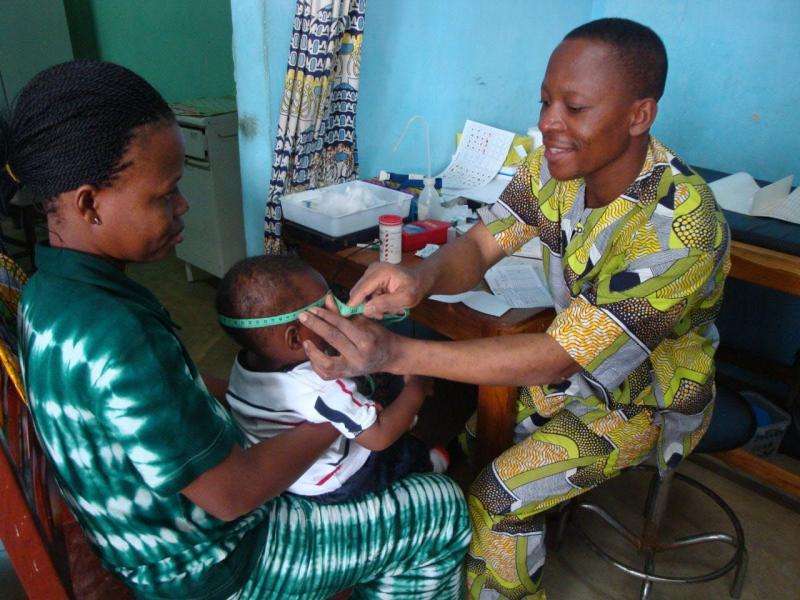Scientists confirm the impact of submicroscopic malarial infections during pregnancy

A scientific study conducted in Benin by researchers from IRD and the Centre for study and research on pregnancy associated malaria and infancy (CERPAGE, Benin) confirms the harmful impact of submicroscopic malarial infections during pregnancy. These complications include maternal anaemia, premature births and low birthweights in children. Moreover, the researchers show that, in diagnosing malarial infections, molecular biology techniques are more sensitive than the classical microscopic examinations, with 40% of infections detected by the former as against 16% by the latter. These results, published in the Clinical Infectious Diseases journal, will permit drawing particular attention to these infections, in order to improve malarial prevention strategies for pregnant women and newborn babies, particularly those affected by the disease in Sub-Saharan Africa.
Malaria is the cause of more than 580,000 deaths per annum, mainly in Sub-Saharan Africa. Among the parasites transmitted to humans, Plasmodium falciparum is responsible for the deadliest cases. Malarial infections during pregnancy have particularly harmful consequences for maternal and infant health – they cause 35% of premature births with low birthweight and contribute to numerous infant deaths (between 75,000 and 200,000 per annum). This is why the WHO recommends the administration of an intermittent preventive treatment during pregnancy.
Rapid diagnosis of the infections is also essential in the fight against malaria. The diagnosis rests mainly on the microscopic examination of blood samples (thick blood smear) and on the use of the rapid diagnostic test (RDT) recommended by the WHO. However, these techniques lack sensitivity (only one-third of infections detected), notably in detecting sub-microscopic infections.
More effective molecular biology techniques
In this prospective study, carried out between May 2008 and May 2011, the researchers monitored 1,037 pregnant women in south-west Benin (villages of Comé, Ouédeme-Pedah and Akodeha), during pregnancy, in order to assess, for the first time, the impact of submicroscopic malarial infections on maternal anaemia, premature births and low birthweights in newborn babies. For this, they compared the classical microscopic diagnostic techniques (thick blood smear and RDT) and the molecular biology technique, Polymerase Chain Reaction (PCR).
The multivariate statistical analyses confirmed the significant impact of submicroscopic malarial infections during pregnancy on the health of the mother and the child. This is particularly the case during a first pregnancy, where a significant increase in the risk of low birthweight in newborn babies and anaemia in the mother were observed, but also in women who have already had several pregnancies: approximately twice the risk of premature birth.
The researchers also confirmed the relevance of the WHO recommendations which advocate increasing the number of intermittent preventive treatment doses received by women during pregnancy. In fact, with the present treatment comprising two doses, 30% of women monitored in the study were infected at delivery.
Finally, PCR is much more effective than the microscopy techniques in detecting malarial infections in pregnant women. This permitted detecting the malarial agent in 40% of the women monitored – as against 16% for the microscopy at the time of the first prenatal consultation – clearly highlighting the consequences of these underlying infections on the health of the mother and the child.
Towards the improvement of strategies to eliminate malaria
This was the first time that a prospective study of this scale was conducted on the impact of submicroscopic infections on maternal and infant health. The results question the relevance of the malarial diagnostic tools recommended at present – which only permit detecting one-third of the infections. They pave the way to improving strategies to eliminate this illness.
The researchers emphasise the need to better assess the role of these submicroscopic infections as parasite reservoirs facilitating transmission in different populations (pregnant women, children, adults). They point out that it is essential to better characterise the pregnancy periods of highest risk to the health of the mother and child. They call for increased research aimed at developing molecular diagnostic tools that are more effective and useable in the field.
More information: "Submicroscopic Plasmodium falciparum infections are associated with maternal anemia, premature births and low birthweight" Clin Infect Dis. first published online February 18, 2015 DOI: 10.1093/cid/civ122














